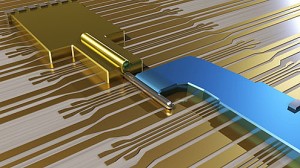Described in a 2011 BBC news item as an internet/wikipedia for robots only, RobotEarth was last mentioned here in a Feb. 14, 2011 posting (scroll down about 1/3 of the way) where I featured both the aforementioned BBC news item and a first person account of the project on the IEEE (Institute of Electrical and Electronics Engineering) Spectrum’s Automaton Robotics blog.
Today, Mar. 12, 2013, there’s a news release on EurekAlert about a new RoboEarth development,
Researchers of five European universities have developed a cloud-computing platform for robots. The platform allows robots connected to the Internet to directly access the powerful computational, storage, and communications infrastructure of modern data centers – the giant server farms behind the likes of Google, Facebook, and Amazon – for robotics tasks and robot learning.
With the development of the RoboEarth Cloud Engine the team continues their work towards creating an Internet for robots. The new platform extends earlier work on allowing robots to share knowledge with other robots via a WWW-style database, greatly speeding up robot learning and adaptation in complex tasks.
Here’s how the cloud engine is described,
The developed Platform as a Service (PaaS) for robots allows to perform complex functions like mapping, navigation, or processing of human voice commands in the cloud, at a fraction of the time required by robots’ on-board computers. By making enterprise-scale computing infrastructure available to any robot with a wireless connection, the researchers believe that the new computing platform will help pave the way towards lighter, cheaper, more intelligent robots.
“The RoboEarth Cloud Engine is particularly useful for mobile robots, such as drones or autonomous cars, which require lots of computation for navigation. It also offers significant benefits for robot co-workers, such as factory robots working alongside humans, which require large knowledge databases, and for the deployment of robot teams.” says Mohanarajah Gajamohan, researcher at the Swiss Federal Institute of Technology (ETH Zurich) and Technical Lead of the project.
“On-board computation reduces mobility and increases cost.”, says Dr. Heico Sandee, RoboEarth’s Program Manager at Eindhoven University of Technology in the Netherlands, “With the rapid increase in wireless data rates caused by the booming demand of mobile communications devices, more and more of a robot’s computational tasks can be moved into the cloud.”
Oddly, there’s never any mention of the name for the cloud engine project in the news release. I found the name (Rapyuta) on the RoboEarth website, from the home page,
Update: Join (or remotely watch) the Cloud Robotics Workshop at the EU Robotics Forum on Wednesday 20. March, 4-6pm CET. Details: http://www.roboearth.org/eurobotics2013
It is our pleasure to announce the first public release of Rapyuta: The RoboEarth Cloud Engine. Rapyuta is an open source cloud robotics platform for robots. It implements a Platform-as-a-Service (PaaS) framework designed specifically for robotics applications.
Rapyuta helps robots to offload heavy computation by providing secured customizable computing environments in the cloud. Robots can start their own computational environment, launch any computational node uploaded by the developer, and communicate with the launched nodes using the WebSockets protocol.
Interestingly, the final paragraph of today’s (Mar. 12, 2011) news release includes a statement about jobs,
While high-tech companies that heavily rely on data centers have been criticized for creating fewer jobs than traditional companies (e.g., Google or Facebook employ less than half the number of workers of General Electric or Hewlett-Packard per dollar in revenue), the researchers don’t believe that this new robotics platform should be cause for alarm. According to a recent study by the International Federation of Robotics and Metra Martech entitled “Positive Impact of Industrial Robots on Employment”, robots don’t kill jobs but rather tend to lead to an overall growth in jobs.
I’d like to see some more data about this business of robots creating jobs. In the meantime, there’s more information about RoboEarth and the Rapyuta cloud engine in the links the news release provides to materials such as this video,
Unexpectedly, the narrator sounds like she might have been educated in Canada or the US.
![This graphic displays spin qubits within a nanowire. [downloaded from http://www.news.pitt.edu/connecting-quantum-dots]](http://www.frogheart.ca/wp-content/uploads/2013/02/SpinQBitsNanowire-213x300.jpg)
